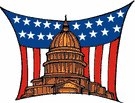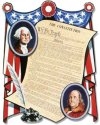By Phyllis Naegeli

|
The Courts of the Judicial Branch
By Phyllis Naegeli |

|
 1 Article III of the United States Constitution established the Supreme Court as the highest court in our land. The power granted to the court to decide cases involving federal or constitutional law was set up to check the balance of power within the government. This Article also granted Congress the authority to create lower courts as needed. Congress exercised this power in 1789 when they passed the Judiciary Act establishing the lower district courts.
1 Article III of the United States Constitution established the Supreme Court as the highest court in our land. The power granted to the court to decide cases involving federal or constitutional law was set up to check the balance of power within the government. This Article also granted Congress the authority to create lower courts as needed. Congress exercised this power in 1789 when they passed the Judiciary Act establishing the lower district courts. |
Create Weekly Reading Books
Prepare for an entire week at once! |
 |
The 1890's
|
 |
American Government Worksheets | edHelper.com
|
 |
United States Constitution
|
 |
High School Reading Comprehensions and High School Reading Lessons
|
 |
Social Studies
|
 |
United States
|
|
|
|
|
 | Fifty States Theme Unit |
 |
Document Based Activities |